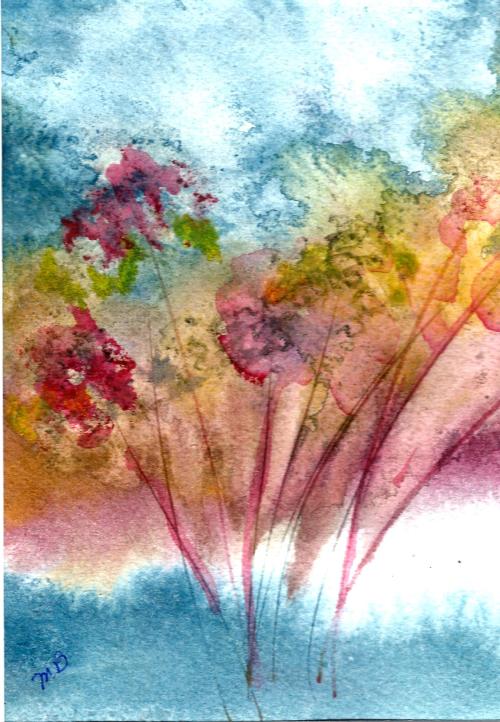Awhile back I overheard an hilarious comment made by my husband, Joe, when he was on the phone with his cousin, Tom in Minnesota. Joe was catching Tom up on our lifestyle, and he said: “Margaret paints a lot but she doesn’t paint what it is.” Too funny, and so true!
A few days later, a ten year old great-granddaughter, Brynn, was visiting. She sat at our dining room table, gazed around at the walls, and then remarked to me: “Your paintings are beautiful. If someone would tell me what they are I’d think they were even more beautiful!” Too precious!
Yes, I love abstract art with perhaps just a little hint at “what it is”: out-of-focus renderings with no consideration of accurate representation or correct perspective. I’ll share an obvious secret with you: I cannot draw worth a hoot, so the above descriptions of my efforts are accurate and all I can successfully do. My trump card is COLOR and I am delighted to be able to manage that!
But also, the fuzzy/blurry/far-out kind of art is exactly what I like in our home—with a few exceptions: my friend, Janet Roberts’s* large, drop-dead-gorgeous, realistic oil paintings which Joe and I are privileged to own and display; some 19th century tinted family photographs in exquisite antique frames; a slew of wild-west prints culled from antique shops and yard sales; and plenty of current family photos.
I love it when someone asks me what I had in mind with a specific painting. Sometimes, not much I’ll admit. But other times I’m thinking of something in the process. The above sample incorporates my nostalgia for the campfires we had every April through September when we lived on a lake in the wild Wisconsin northwoods.
I painted the campfire as a raging inferno, with good reason: I was recalling a friend who visited and insisted on throwing huge fallen branches and loads of birch bark in the fire pit while causing Joe and me to hold our breath in astonishment and a bit of concern. But we had a hose handy and never needed to use it. “Thank you, Lord!”
Here are some more “not what it is” paintings:
1) Outside the small cathedral where our granddaughter, Jamie, and her Leonardo were married on an unbelievably perfect September day in 2013: For me, the main things to convey were the autumn sunshine, the Norman architecture of St. John’s Northwest Military Academy Cathedral, and the red door which—on Episcopal Churches—symbolizes the shed blood of our Savior on Calvary. ⇓
2) An imaginary glimpse at city life at its creative best—with plenty of planting against walls and in courtyards, and many islands of greenery: Years ago Joe and I toured the countryside in England, Scotland, and Wales—staying on sheep farms and basking in the goodness of it all. On our last day in Britain, we stayed in the country near Gatwick Airport, and took a train from Dorking to London. All the way into the city I marveled at back yards viewed from the train—nearly every one with a welcoming little garden and garden shed.
Such a garden-oriented city culture is wonderful to me! There may be many in the USA as well, but the only such cities I have visited are San Francisco CA and Bellingham WA. Maybe due to our local climate, year-around city beauty is hard to find in Midwest USA. Yet Britain has long been especially known for gardening passion. ⇓
A not-so-obscure image of one of my favorite states, New Mexico—where terra-cotta, turquois, and coral colors predominate and the air is redolent with the fragrance of piñon pines: ⇓
Here is a collage which I did several years ago, while dreaming of the Japanese Tea Garden in San Francisco—in line with the previously depicted “creative garden city” rendering: ⇓
One of my favorite high school memories is that of performing in the chorus of Gilbert and Sullivan’s H.M.S. Pinafore. Forever, Little Buttercup’s solo, “Things are seldom what they seem; skim milk masquerades as cream . . . .” will ring in my ears. That’s the case with my art. It’s not what it is! 🙂
Margaret L. Been — June 3rd, 2017
*For a treat, you can GOOGLE “Janet Roberts, Fine Artist, Brookfield Wisconsin.

























